Meri's Stroke Rehabilitation: Functional Capacity Evaluation & BBS
VerifiedAdded on 2023/03/31
|5
|902
|475
Case Study
AI Summary
This case study examines stroke rehabilitation strategies for a patient named Meri, emphasizing the importance of early intervention to regain lost skills. It highlights the application of two key assessment tools: Functional Capacity Evaluation (FCE) and Berg Balance Scale (BBS). FCE is used to assess Meri's ability to perform tasks safely and independently, determining appropriate treatment programs and evaluating hand-related functions. The BBS, originally designed for senior citizens, is applied to assess Meri's balance and fall risk, considering her age and post-stroke condition. The study concludes that these assessment tools are crucial for identifying patient needs and facilitating effective rehabilitation, ultimately improving Meri's functional ability and safety balance. Desklib provides access to similar solved assignments for students.
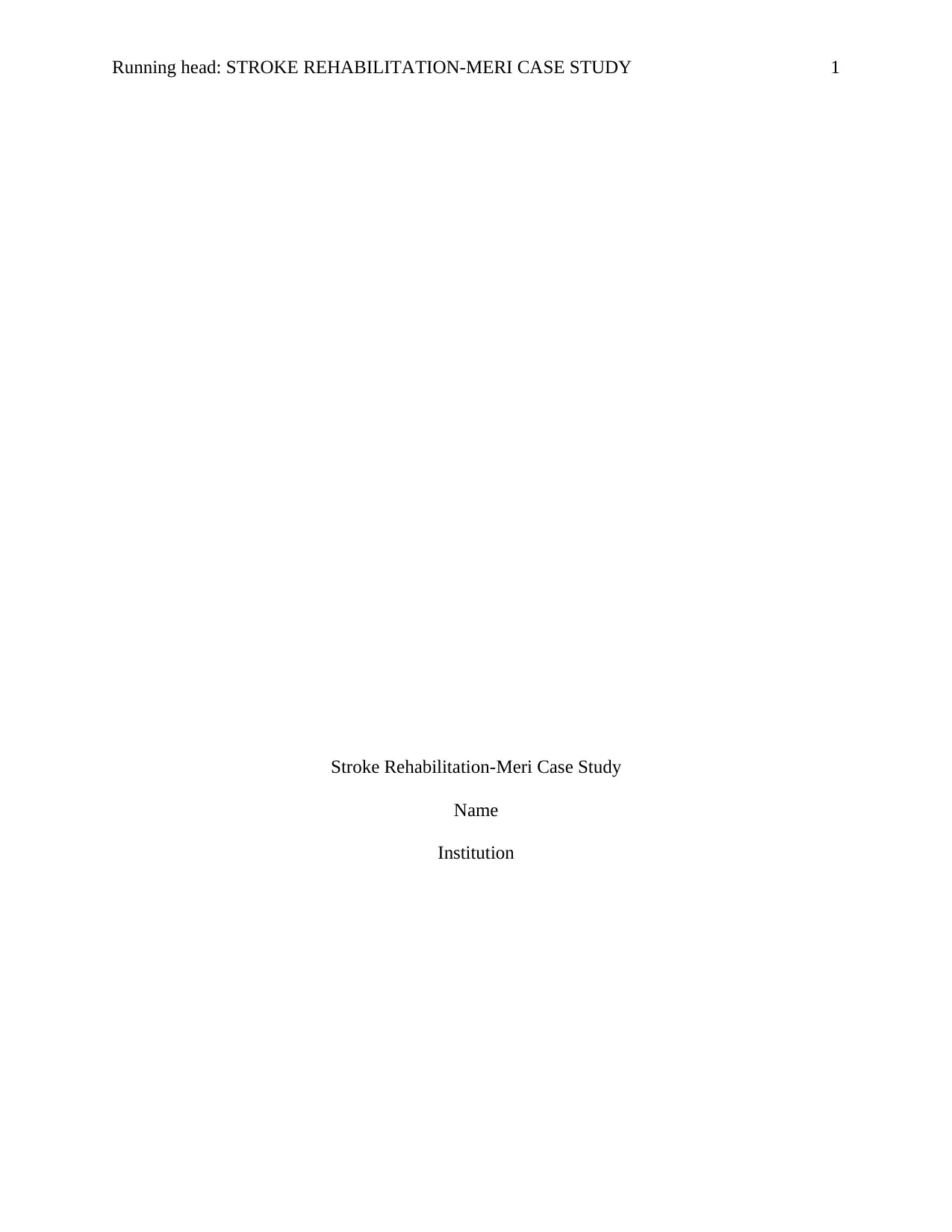
Running head: STROKE REHABILITATION-MERI CASE STUDY 1
Stroke Rehabilitation-Meri Case Study
Name
Institution
Stroke Rehabilitation-Meri Case Study
Name
Institution
Paraphrase This Document
Need a fresh take? Get an instant paraphrase of this document with our AI Paraphraser
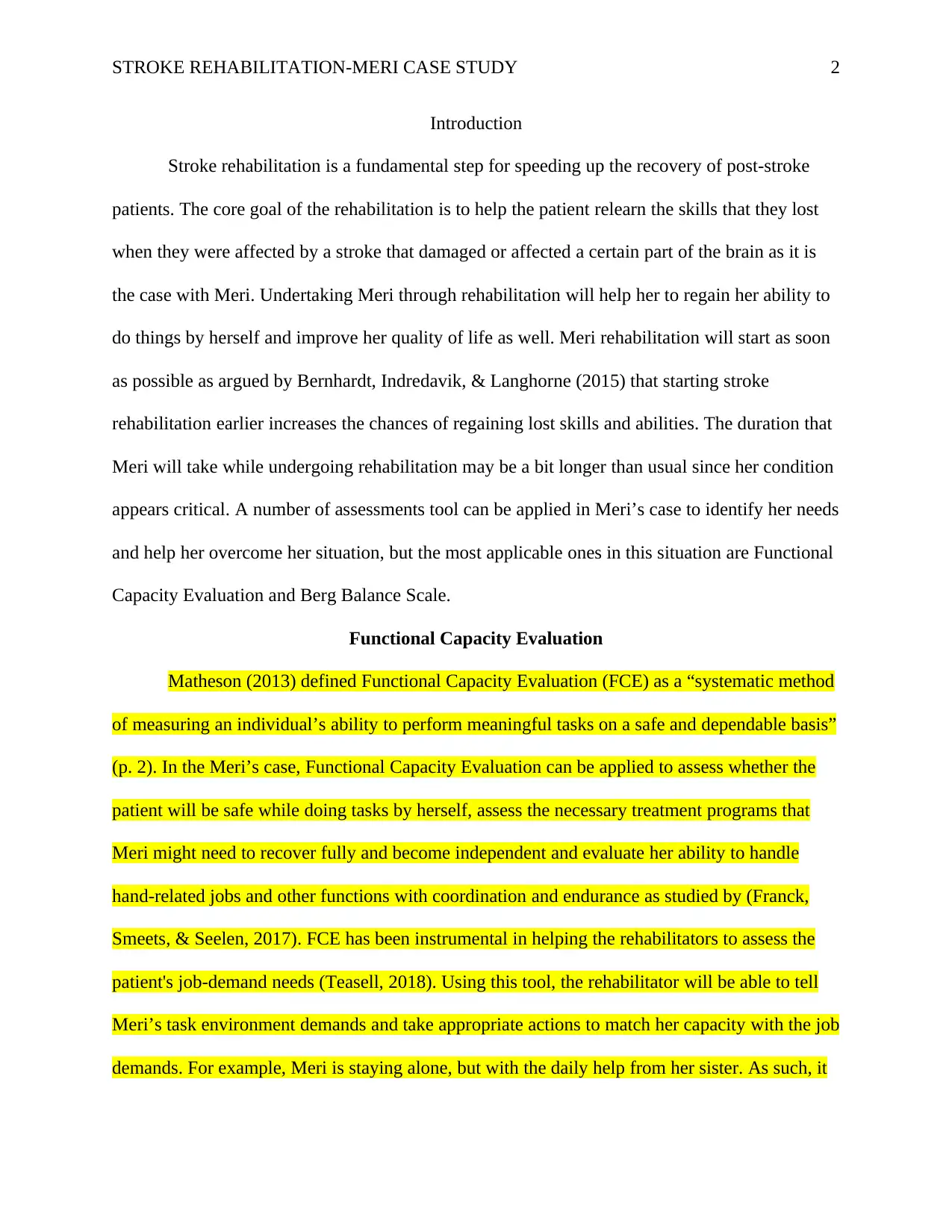
STROKE REHABILITATION-MERI CASE STUDY 2
Introduction
Stroke rehabilitation is a fundamental step for speeding up the recovery of post-stroke
patients. The core goal of the rehabilitation is to help the patient relearn the skills that they lost
when they were affected by a stroke that damaged or affected a certain part of the brain as it is
the case with Meri. Undertaking Meri through rehabilitation will help her to regain her ability to
do things by herself and improve her quality of life as well. Meri rehabilitation will start as soon
as possible as argued by Bernhardt, Indredavik, & Langhorne (2015) that starting stroke
rehabilitation earlier increases the chances of regaining lost skills and abilities. The duration that
Meri will take while undergoing rehabilitation may be a bit longer than usual since her condition
appears critical. A number of assessments tool can be applied in Meri’s case to identify her needs
and help her overcome her situation, but the most applicable ones in this situation are Functional
Capacity Evaluation and Berg Balance Scale.
Functional Capacity Evaluation
Matheson (2013) defined Functional Capacity Evaluation (FCE) as a “systematic method
of measuring an individual’s ability to perform meaningful tasks on a safe and dependable basis”
(p. 2). In the Meri’s case, Functional Capacity Evaluation can be applied to assess whether the
patient will be safe while doing tasks by herself, assess the necessary treatment programs that
Meri might need to recover fully and become independent and evaluate her ability to handle
hand-related jobs and other functions with coordination and endurance as studied by (Franck,
Smeets, & Seelen, 2017). FCE has been instrumental in helping the rehabilitators to assess the
patient's job-demand needs (Teasell, 2018). Using this tool, the rehabilitator will be able to tell
Meri’s task environment demands and take appropriate actions to match her capacity with the job
demands. For example, Meri is staying alone, but with the daily help from her sister. As such, it
Introduction
Stroke rehabilitation is a fundamental step for speeding up the recovery of post-stroke
patients. The core goal of the rehabilitation is to help the patient relearn the skills that they lost
when they were affected by a stroke that damaged or affected a certain part of the brain as it is
the case with Meri. Undertaking Meri through rehabilitation will help her to regain her ability to
do things by herself and improve her quality of life as well. Meri rehabilitation will start as soon
as possible as argued by Bernhardt, Indredavik, & Langhorne (2015) that starting stroke
rehabilitation earlier increases the chances of regaining lost skills and abilities. The duration that
Meri will take while undergoing rehabilitation may be a bit longer than usual since her condition
appears critical. A number of assessments tool can be applied in Meri’s case to identify her needs
and help her overcome her situation, but the most applicable ones in this situation are Functional
Capacity Evaluation and Berg Balance Scale.
Functional Capacity Evaluation
Matheson (2013) defined Functional Capacity Evaluation (FCE) as a “systematic method
of measuring an individual’s ability to perform meaningful tasks on a safe and dependable basis”
(p. 2). In the Meri’s case, Functional Capacity Evaluation can be applied to assess whether the
patient will be safe while doing tasks by herself, assess the necessary treatment programs that
Meri might need to recover fully and become independent and evaluate her ability to handle
hand-related jobs and other functions with coordination and endurance as studied by (Franck,
Smeets, & Seelen, 2017). FCE has been instrumental in helping the rehabilitators to assess the
patient's job-demand needs (Teasell, 2018). Using this tool, the rehabilitator will be able to tell
Meri’s task environment demands and take appropriate actions to match her capacity with the job
demands. For example, Meri is staying alone, but with the daily help from her sister. As such, it
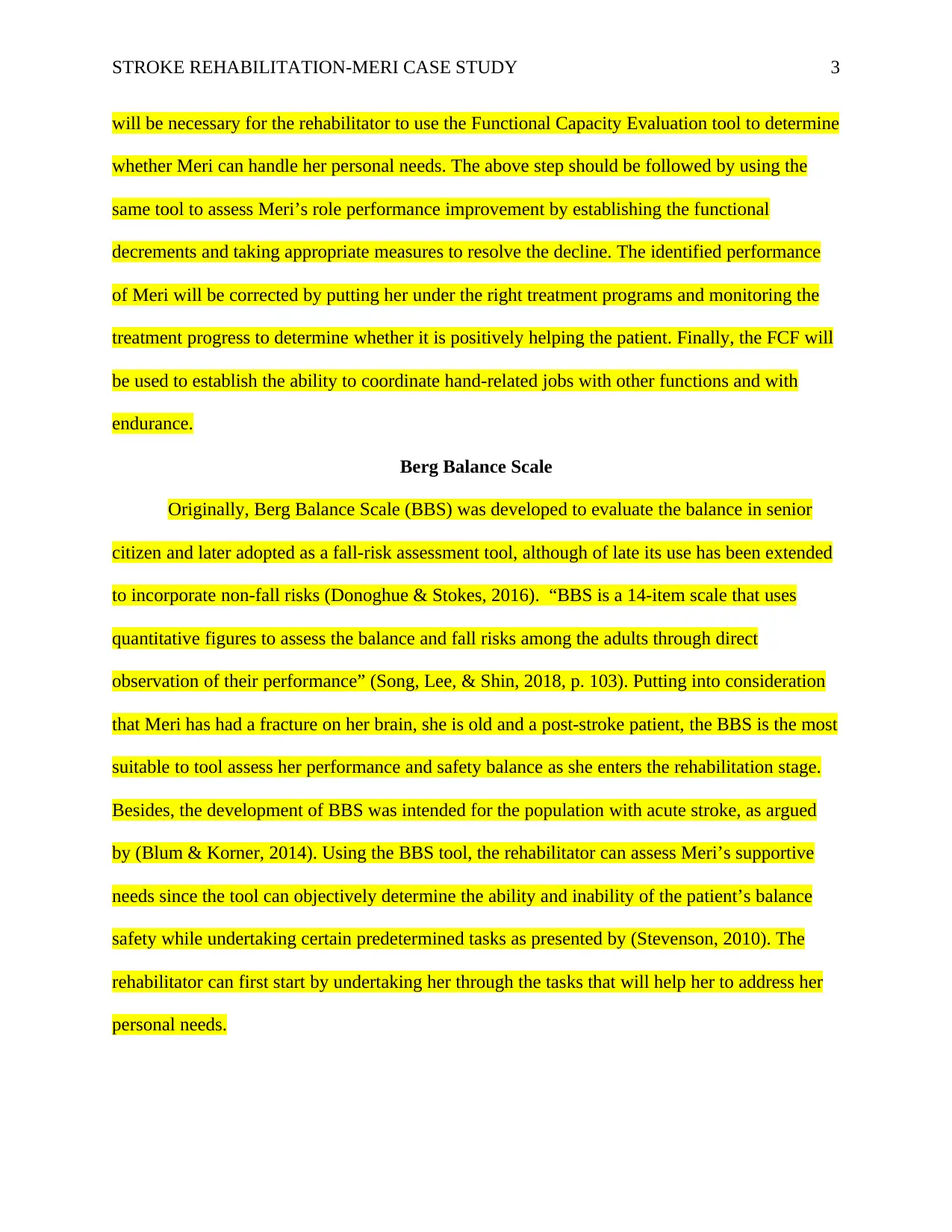
STROKE REHABILITATION-MERI CASE STUDY 3
will be necessary for the rehabilitator to use the Functional Capacity Evaluation tool to determine
whether Meri can handle her personal needs. The above step should be followed by using the
same tool to assess Meri’s role performance improvement by establishing the functional
decrements and taking appropriate measures to resolve the decline. The identified performance
of Meri will be corrected by putting her under the right treatment programs and monitoring the
treatment progress to determine whether it is positively helping the patient. Finally, the FCF will
be used to establish the ability to coordinate hand-related jobs with other functions and with
endurance.
Berg Balance Scale
Originally, Berg Balance Scale (BBS) was developed to evaluate the balance in senior
citizen and later adopted as a fall-risk assessment tool, although of late its use has been extended
to incorporate non-fall risks (Donoghue & Stokes, 2016). “BBS is a 14-item scale that uses
quantitative figures to assess the balance and fall risks among the adults through direct
observation of their performance” (Song, Lee, & Shin, 2018, p. 103). Putting into consideration
that Meri has had a fracture on her brain, she is old and a post-stroke patient, the BBS is the most
suitable to tool assess her performance and safety balance as she enters the rehabilitation stage.
Besides, the development of BBS was intended for the population with acute stroke, as argued
by (Blum & Korner, 2014). Using the BBS tool, the rehabilitator can assess Meri’s supportive
needs since the tool can objectively determine the ability and inability of the patient’s balance
safety while undertaking certain predetermined tasks as presented by (Stevenson, 2010). The
rehabilitator can first start by undertaking her through the tasks that will help her to address her
personal needs.
will be necessary for the rehabilitator to use the Functional Capacity Evaluation tool to determine
whether Meri can handle her personal needs. The above step should be followed by using the
same tool to assess Meri’s role performance improvement by establishing the functional
decrements and taking appropriate measures to resolve the decline. The identified performance
of Meri will be corrected by putting her under the right treatment programs and monitoring the
treatment progress to determine whether it is positively helping the patient. Finally, the FCF will
be used to establish the ability to coordinate hand-related jobs with other functions and with
endurance.
Berg Balance Scale
Originally, Berg Balance Scale (BBS) was developed to evaluate the balance in senior
citizen and later adopted as a fall-risk assessment tool, although of late its use has been extended
to incorporate non-fall risks (Donoghue & Stokes, 2016). “BBS is a 14-item scale that uses
quantitative figures to assess the balance and fall risks among the adults through direct
observation of their performance” (Song, Lee, & Shin, 2018, p. 103). Putting into consideration
that Meri has had a fracture on her brain, she is old and a post-stroke patient, the BBS is the most
suitable to tool assess her performance and safety balance as she enters the rehabilitation stage.
Besides, the development of BBS was intended for the population with acute stroke, as argued
by (Blum & Korner, 2014). Using the BBS tool, the rehabilitator can assess Meri’s supportive
needs since the tool can objectively determine the ability and inability of the patient’s balance
safety while undertaking certain predetermined tasks as presented by (Stevenson, 2010). The
rehabilitator can first start by undertaking her through the tasks that will help her to address her
personal needs.
⊘ This is a preview!⊘
Do you want full access?
Subscribe today to unlock all pages.

Trusted by 1+ million students worldwide
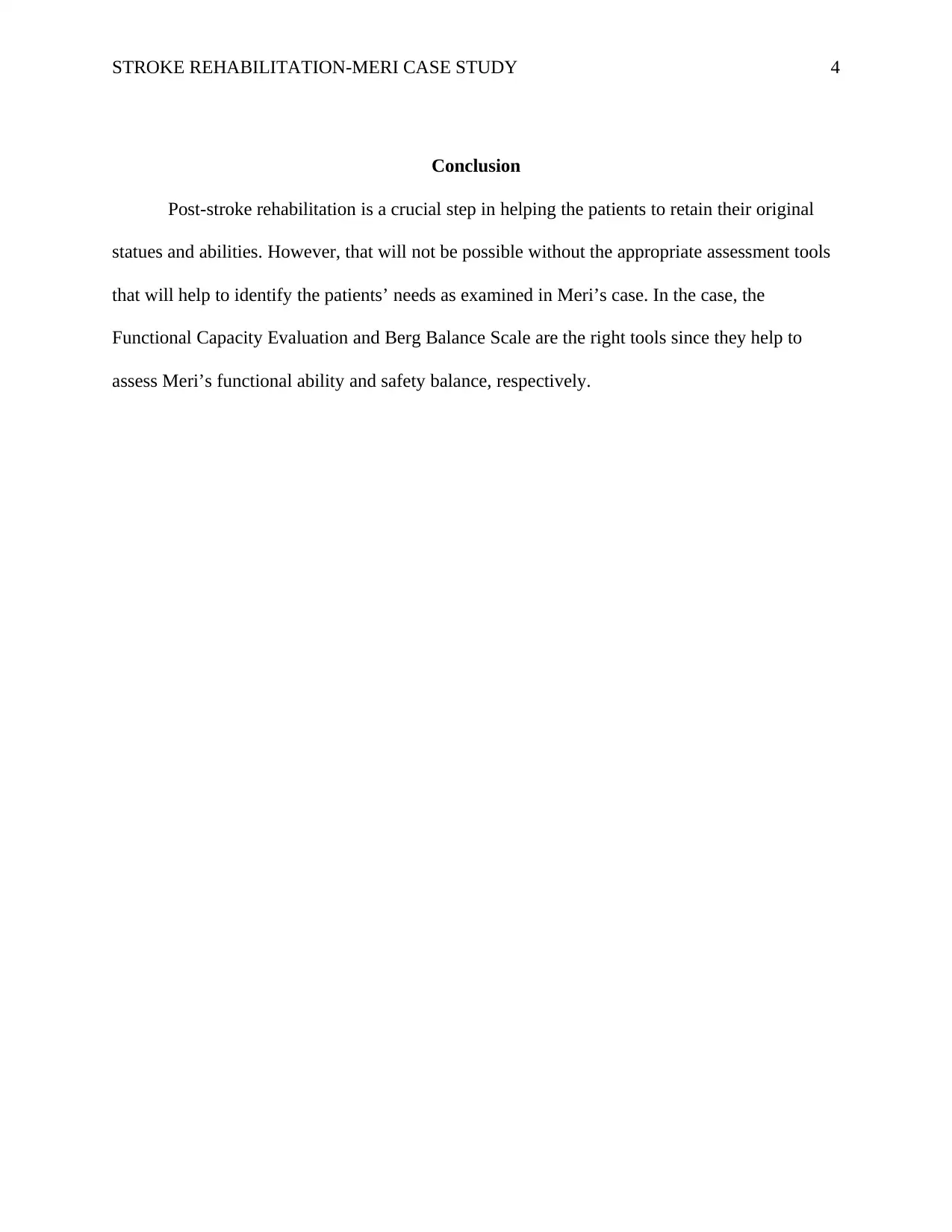
STROKE REHABILITATION-MERI CASE STUDY 4
Conclusion
Post-stroke rehabilitation is a crucial step in helping the patients to retain their original
statues and abilities. However, that will not be possible without the appropriate assessment tools
that will help to identify the patients’ needs as examined in Meri’s case. In the case, the
Functional Capacity Evaluation and Berg Balance Scale are the right tools since they help to
assess Meri’s functional ability and safety balance, respectively.
Conclusion
Post-stroke rehabilitation is a crucial step in helping the patients to retain their original
statues and abilities. However, that will not be possible without the appropriate assessment tools
that will help to identify the patients’ needs as examined in Meri’s case. In the case, the
Functional Capacity Evaluation and Berg Balance Scale are the right tools since they help to
assess Meri’s functional ability and safety balance, respectively.
Paraphrase This Document
Need a fresh take? Get an instant paraphrase of this document with our AI Paraphraser
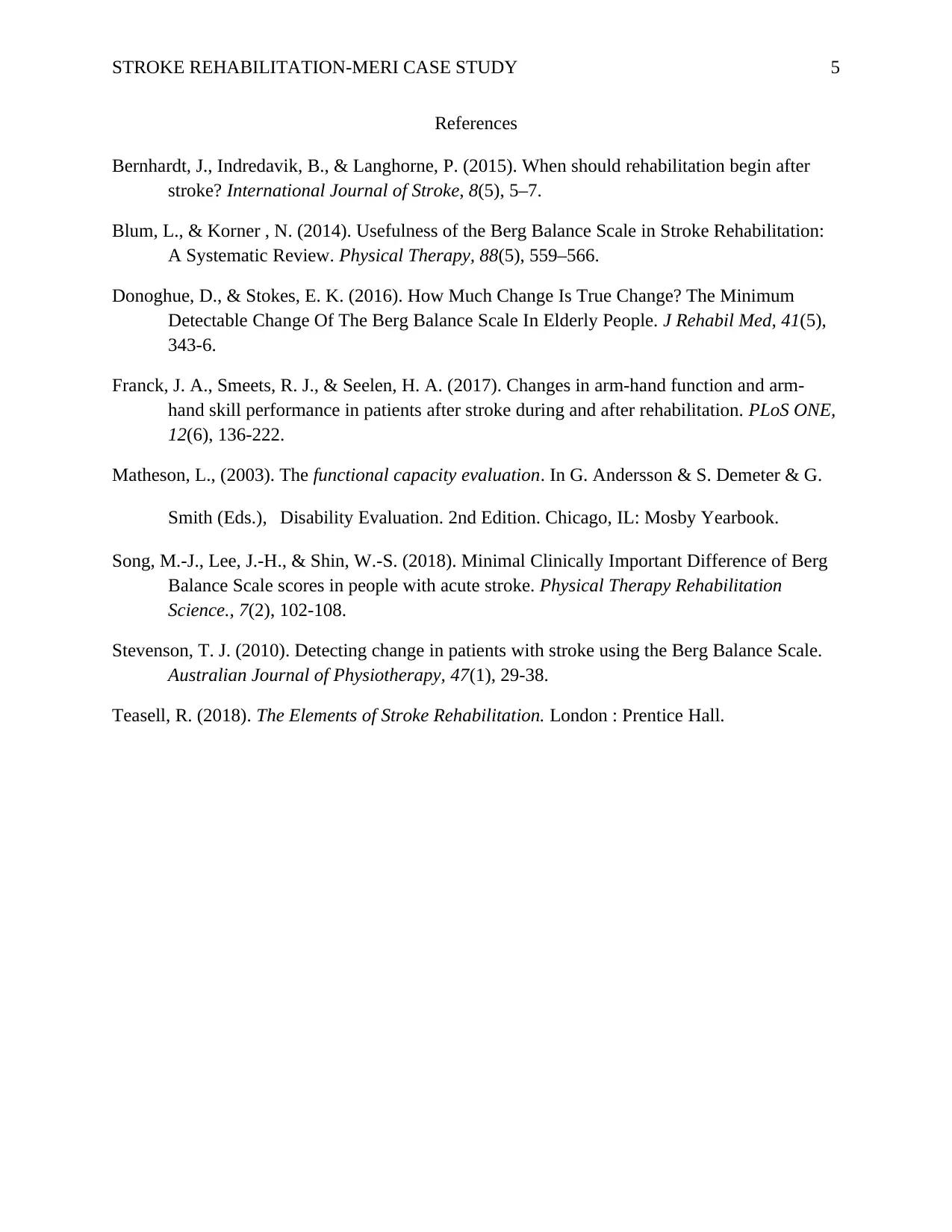
STROKE REHABILITATION-MERI CASE STUDY 5
References
Bernhardt, J., Indredavik, B., & Langhorne, P. (2015). When should rehabilitation begin after
stroke? International Journal of Stroke, 8(5), 5–7.
Blum, L., & Korner , N. (2014). Usefulness of the Berg Balance Scale in Stroke Rehabilitation:
A Systematic Review. Physical Therapy, 88(5), 559–566.
Donoghue, D., & Stokes, E. K. (2016). How Much Change Is True Change? The Minimum
Detectable Change Of The Berg Balance Scale In Elderly People. J Rehabil Med, 41(5),
343-6.
Franck, J. A., Smeets, R. J., & Seelen, H. A. (2017). Changes in arm-hand function and arm-
hand skill performance in patients after stroke during and after rehabilitation. PLoS ONE,
12(6), 136-222.
Matheson, L., (2003). The functional capacity evaluation. In G. Andersson & S. Demeter & G.
Smith (Eds.), Disability Evaluation. 2nd Edition. Chicago, IL: Mosby Yearbook.
Song, M.-J., Lee, J.-H., & Shin, W.-S. (2018). Minimal Clinically Important Difference of Berg
Balance Scale scores in people with acute stroke. Physical Therapy Rehabilitation
Science., 7(2), 102-108.
Stevenson, T. J. (2010). Detecting change in patients with stroke using the Berg Balance Scale.
Australian Journal of Physiotherapy, 47(1), 29-38.
Teasell, R. (2018). The Elements of Stroke Rehabilitation. London : Prentice Hall.
References
Bernhardt, J., Indredavik, B., & Langhorne, P. (2015). When should rehabilitation begin after
stroke? International Journal of Stroke, 8(5), 5–7.
Blum, L., & Korner , N. (2014). Usefulness of the Berg Balance Scale in Stroke Rehabilitation:
A Systematic Review. Physical Therapy, 88(5), 559–566.
Donoghue, D., & Stokes, E. K. (2016). How Much Change Is True Change? The Minimum
Detectable Change Of The Berg Balance Scale In Elderly People. J Rehabil Med, 41(5),
343-6.
Franck, J. A., Smeets, R. J., & Seelen, H. A. (2017). Changes in arm-hand function and arm-
hand skill performance in patients after stroke during and after rehabilitation. PLoS ONE,
12(6), 136-222.
Matheson, L., (2003). The functional capacity evaluation. In G. Andersson & S. Demeter & G.
Smith (Eds.), Disability Evaluation. 2nd Edition. Chicago, IL: Mosby Yearbook.
Song, M.-J., Lee, J.-H., & Shin, W.-S. (2018). Minimal Clinically Important Difference of Berg
Balance Scale scores in people with acute stroke. Physical Therapy Rehabilitation
Science., 7(2), 102-108.
Stevenson, T. J. (2010). Detecting change in patients with stroke using the Berg Balance Scale.
Australian Journal of Physiotherapy, 47(1), 29-38.
Teasell, R. (2018). The Elements of Stroke Rehabilitation. London : Prentice Hall.
1 out of 5
Related Documents
Your All-in-One AI-Powered Toolkit for Academic Success.
+13062052269
info@desklib.com
Available 24*7 on WhatsApp / Email
![[object Object]](/_next/static/media/star-bottom.7253800d.svg)
Unlock your academic potential
Copyright © 2020–2025 A2Z Services. All Rights Reserved. Developed and managed by ZUCOL.




